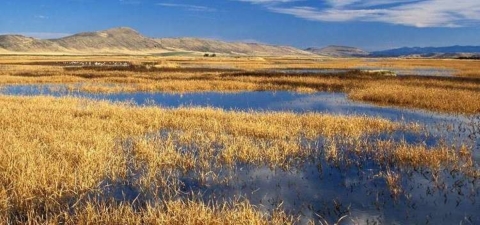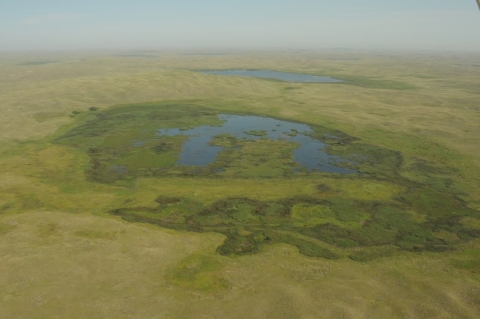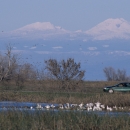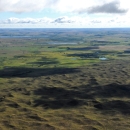About Us
Refuge Establishment
Crescent Lake National Wildlife Refuge was established in 1931, and is located 28 miles north of Oshkosh, Nebraska in Garden County. It is administered by the U.S. Fish & Wildlife Service and is within the Central Flyway. This little known refuge is located in the Nebraska panhandle and is within the largest continuous sand dune area in the United States. The grass covered dunes were created from the wind blown sands of an ancient sea.
The Refuge is governed in part by the National Wildlife Refuge System (NWRS) Improvement Act of 1997. The NWRS Improvement Act defines a unifying mission for all refuges, including a process for determining compatible uses on refuges, and requiring that each refuge be managed according to a Plan. The NWRS Improvement Act expressly states that wildlife conservation is the priority of System lands and that the Secretary shall ensure that the biological integrity, diversity, and environmental health of refuge lands are maintained. Each refuge must be managed to fulfill the specific purposes for which the refuge was established and the System mission. The main priority of each refuge is to conserve, manage, and if needed, restore fish and wildlife populations and habitats according to its purpose.
Refuge Habitats
The Refuge contains 1,076 acres of designated Research Natural Areas (Goose Lake and Hackberry Units), and also a proposed Wilderness Area of 24,502 acres which encompasses the eastern half of the Refuge.
Habitat types on the Refuge are sub-irrigated meadows (4,126 acres); uplands (33,014 acres), and wetlands (8,709 acres) which include 21 lakes and numerous small wetlands. Sub-irrigated meadows occur in-between the dunes where the groundwater is close enough to the surface to allow plant roots to reach it. The constant supply of water allows greater numbers of plants to grow more abundantly. Uplands are "high ground" elevated above wetlands, streams, etc. and are generally dry. Wetlands are areas where water covers the soil, or is present either at or near the surface of the soil all year or for varying periods of time during the year, including during the growing season.
The Sandhills are within a wide transitional zone called the mixed-grass prairie, which lies between tallgrass prairie to the east and short grass prairie to the west. Although precipitation is typical of the semi-arid mixed-grass prairie, the Sandhills are characterized by "climax", tallgrass species. The climax stage is reached when the final community becomes more or less stabilized for a longer period of time and species can maintain themselves within the climate of a given area.
Our Mission
Each unit of the National Wildlife Refuge System is established to serve a statutory purpose that targets the conservation of native species dependent on its lands and waters. All activities on those acres are reviewed for compatibility with this statutory purpose.
A sea of grass in a sea of grass, Crescent Lake National Wildlife Refuge was established under Executive Order 5597 to serve as "a refuge and breeding ground for birds and wild animals,” particularly migratory birds.
Like all national wildlife refuges, Crescent Lake Refuge is not an island independent of its surroundings. It is part of larger and dynamic social, economic and biological communities; communities that affect Refuge wildlife. Crescent Lake NWR is surrounded primarily by lands that are grazed by cattle, public use is relatively low and outside threats to habitat health are few.
The purpose of Crescent Lake Refuge is to maintain a representative sample of the native prairie and wildlife associated with this part of the Nebraska Sandhills. Refuge staff work to maintain habitat in excellent condition, fewer exotic plants, and a healthy and growing population of blowout penstemon, an endangered plant. The Refuge provides the visiting public the value of solitude and high quality learning and recreational facilities. The goal is to provide habitat for migratory birds enjoyed by people in states up and down the Central Flyway. Refuge staff participate in active partnerships with surrounding landowners to help them maintain habitat on private lands while engaged in sustained, profitable agriculture.
Our History
Little formal archaeological work has been conducted within the Nebraska Sandhills. Cursory collections by archaeologists indicate the area has a long prehistoric record and that artifacts are widely distributed; however, because of the unique nature of the Sandhills, settlement and subsistence patterns are difficult to predict. No surveys have been conducted on the Refuge, and no known Native American sites are known to exist.
Historic use of the Sandhills includes only a few fur traders and ranching operations in existence prior to the Federal government’s decision to survey the region and make it available for homesteading in 1904. These homesteaders attempted to farm their land; however, because the soil was almost pure sand, such ventures proved unsuccessful. The region reverted to large livestock spreads and so it remains today. No farm or ranch buildings remain on the Refuge, but old dump sites are still scattered across the area.
Two Refuge buildings and two fire towers built by the Civilian Conservation Corps and through the Works Progress Administration in the 1930's are subject to conditions of Federal laws protecting historic resources.
Other Facilities in this Complex
North Platte National Wildlife Refuge was established in 1916 by Executive Order No. 2446 as a “preserve and breeding ground for native birds.” It is located in the Nebraska Panhandle, near Scottsbluff. It was declared a National Wildlife Refuge primarily because of fall concentrations of up to 250,000 mallards, 11,000 Canada geese and bald eagles.
Fort Niobrara National Wildlife Refuge supports an exceptional diversity of plants and wildlife representative of the northern Great Plains and geographic regions east, west, north, and south of here. In the early 1900s, President Theodore Roosevelt and private conservation organizations, such as the National Audubon Society and American Bison Society, were becoming increasingly concerned with the exploitation of wildlife and their habitats on the Great Plains and elsewhere. As a result, an Executive Order was signed on January 11, 1912, establishing Fort Niobrara as a "preserve and breeding ground for native birds." Later that year, the Refuge's purpose was expanded to include the conservation of bison and elk herds representative of those that once roamed the Great Plains.
Valentine National Wildlife Refuge is 71,516 acres and is located in the Sandhills of north-central Nebraska. The Refuge is a unique and ecologically important component of the National Wildlife Refuge System (System) which includes more than 566 National Wildlife Refuges spanning approximately 100 million acres of lands and 750 million acres of oceans in the United States. The native grass prairie and wetlands found here support a diversity of wildlife. Little has changed from historic times. The Refuge was established by Congress in 1935 “as a breeding ground for migratory birds and other wildlife.” The Refuge is home to 270 species of birds, 59 species of mammals, and 22 species of reptiles and amphibians.
Lacreek National Wildlife Refuge lies in the shallow Lake Creek valley on the northern edge of the Nebraska Sandhills and includes 16,410 acres of native sandhills, sub-irrigated meadows, impounded fresh water marshes, and tall and mixed grass prairie uplands. The Refuge serves as an important staging area for migrating waterfowl, sandhill cranes, shorebirds, and neotropical migrants. Providing critical wintering habitat for the high plains trumpeter swan population is a primary goal.
John W. and Louise Seier National Wildlife Refuge is found in north-central Nebraska, as a sanctuary among the Sandhills. The Sandhills region is the largest remaining tract of mixed and tallgrass prairie in North America. The Seier Ranch was originally homesteaded by John and Louise Seier’s grandparents in the mid-1800's. John and Louise Seier did not have any immediate family, but did have a love of wildlife and an interest in preserving wildlife, they donated their 2,400 acre working cattle ranch to U.S. Fish and Wildlife Service in October of 1999. Because the Refuge is so new to the System, it remains closed to the public at this time. There is no projected date for the opening of the Refuge, however, a date will be established upon the completion of a management plan.







